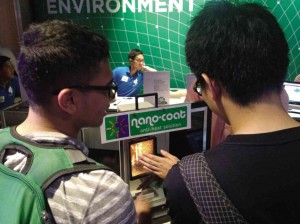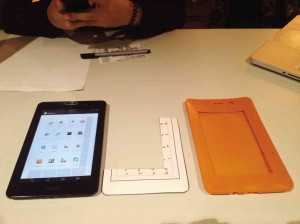‘Aha!’ moments with bright market prospects
Sometimes brilliant ideas come out of the simplest situations.
A college student’s “light bulb” moment in the shower led to an innovation that would empower the blind.
Janna Aika Deja, a graduating multimedia arts student at De La Salle College of St. Benilde (CSB), designed and produced a Braille-embossed silicone case for Android tablets, one of the projects exhibited at the recent two-day DLSU Innovation and Technology Fair that also featured seminars and lectures.
The team of the De La Salle University (DLSU) Innovation and Technology Office led by lawyer Christopher Cruz, with the office of research and innovation, spent months gathering 55 new science and technology projects of students, faculty and staff from all De La Salle schools for the exhibit, now on its second year.
“As I was taking a shower, shampoo got into my eyes. It hurt so bad I couldn’t open them,” Deja said.
Groping her way out of the bathroom, an idea for a thesis was born: How could the blind use today’s technology? How could they use tablets?
She started researching and found that, while there were tablet applications (apps) for the visually impaired, using the gadgets themselves was a struggle.
The visually impaired had to make several frustrating attempts before they could manage to tap the right icon for an app.
Deja resolved to do something. “I wanted them to enjoy today’s technology as much as people with sight, so I tried to come up with a hardware technology that would allow just that.”
Deja had letters and numbers in Braille embossed on the right side and bottom of a tab’s silicone frame, corresponding to the rows and columns of the apps on the interface. Columns used letters while rows were tagged in numbers.
Like computer chess
The concept was similar to a computer chess game where positions of chess pieces were labeled A1, A2, etc.
In Deja’s project, an app would be accessed by pressing two Braille buttons—a letter and a number—corresponding to the location of an icon on the screen.
Eventually, users are expected to memorize the various programs’ locations. According to Deja, some blind people who tested her device said they were very happy with the innovation.
For the prototype of her design, Deja went to Singapore, spending P22,000 for the production of just one case.
Deja, imbued with the spirit of entrepreneurship that DLSU tries to instill in all its students, said she expected the cost to fall sharply to about P100 or so each frame “once it’s officially out commercially” and mass-produced.
Entrepreneurship also drove computer science student Jerome Ibañez. DLSU computer science students, he said, “are trained to be software engineers, software developers or

Officers of DLSU Innovation and Technology Office, led by vice chancellor for research and innovation Raymond Tan (right), and keynote speaker Aileen Apolo-De Jesus (left) of Google Southeast Asia open the two-day fair.
researchers, or ‘technopreneurs.’”
Ibañez and his partners established a startup, Metro Plate, an online healthy food delivery platform open until the wee hours.
Metro Plate is expected to be a welcome alternative to midnight snacks offered by 24-hour fast-food chains that seem to be the only option for most people working the graveyard shift.
Although instruction at DLSU stresses entrepreneurship, going into business is still not easy for young inventors introducing new, even if welcome, technologies.
Four-legged stool
Dr. Gonzalo “Al” Serafica, cofounder of Xylos Corp. USA, said, “The invention is just one leg of the four-legged stool. Do not make the mistake of getting the majority share [of profits] right away.”
Patents and intellectual property rights also cannot be overlooked.
“[When you come up with something,] you should put it out there, have it published and file for a patent because if you don’t, somebody else will,” said Serafica, a chemical engineer who holds a number of US and international patents and has more than a decade of experience in biosynthetic cellulose research.
While most of the projects in the exhibit were created mainly to fulfill academic requirements, graduate student Edward Tibayan’s antiheat solution, Nanocoat, was already up for patenting, a sensible move given the product’s market potential.
Nanocoat is a chemical solution applied to glass, in building windows for example, to reduce significantly the heat passing through it. It is like a clear version of tinted glass, but supposedly works a lot better.
At the exhibit, the heat-absorbing property of the Nanocoated glass was compared to an ordinary clear glass and one with a tint. When a spotlight was turned on, the Nanocoated glass had the coolest surface.
Thesis season seemed to have produced other remarkable ideas, aside from Deja’s.
The thesis project of a group of industrial engineering students from DLSU Dasmariñas was spurred by Super Typhoon “Yolanda” which left scores of families starving and thirsty for several days.
Students Pocholo Molina, Marc Dulguine, Mark Paulo Aguilar, Cyrille Tiangco, Kenneth Rodriguez and Michael Jose saw in the news a machine that converts moisture into potable water. But the machine was as big as a truck and would not be quite mobile. It also needed fuel, making it unsustainable.
Harnessing sun power
The six students created Sol Aer Aqua, a solar-powered atmospheric water generator just a few inches bigger than a mini refrigerator.
It can produce about 2 liters of drinking water in 24 hours of converting moisture in the air.
Four information systems students from CSB, on the other hand, came up with an app that establishes a social network of farmers.
Encouraging users to plant in their own backyards, Green Thumb lists different herbs and crops that grow in different regions of the country, as well as instructions for propagation.
Green Thumb creators Miguel Roque, Sheree Ching, Kayla Suarez and Rocky Descalla hope the app would inspire more people to farm to help ease hunger and poverty.
















